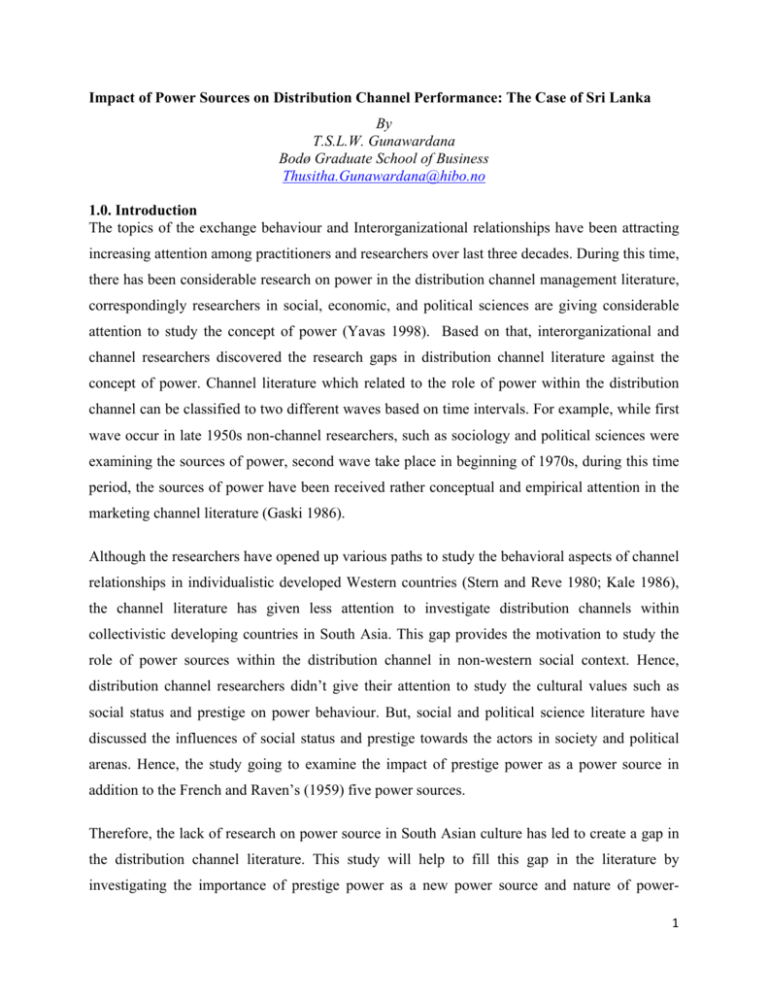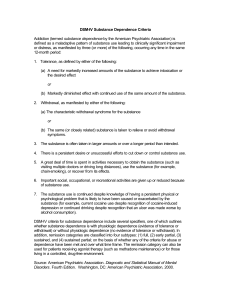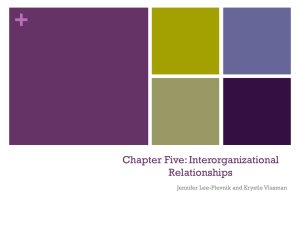Impact of Power Sources on Distribution Channel Performance: The
advertisement

Impact of Power Sources on Distribution Channel Performance: The Case of Sri Lanka By T.S.L.W. Gunawardana Bodø Graduate School of Business Thusitha.Gunawardana@hibo.no 1.0. Introduction The topics of the exchange behaviour and Interorganizational relationships have been attracting increasing attention among practitioners and researchers over last three decades. During this time, there has been considerable research on power in the distribution channel management literature, correspondingly researchers in social, economic, and political sciences are giving considerable attention to study the concept of power (Yavas 1998). Based on that, interorganizational and channel researchers discovered the research gaps in distribution channel literature against the concept of power. Channel literature which related to the role of power within the distribution channel can be classified to two different waves based on time intervals. For example, while first wave occur in late 1950s non-channel researchers, such as sociology and political sciences were examining the sources of power, second wave take place in beginning of 1970s, during this time period, the sources of power have been received rather conceptual and empirical attention in the marketing channel literature (Gaski 1986). Although the researchers have opened up various paths to study the behavioral aspects of channel relationships in individualistic developed Western countries (Stern and Reve 1980; Kale 1986), the channel literature has given less attention to investigate distribution channels within collectivistic developing countries in South Asia. This gap provides the motivation to study the role of power sources within the distribution channel in non-western social context. Hence, distribution channel researchers didn’t give their attention to study the cultural values such as social status and prestige on power behaviour. But, social and political science literature have discussed the influences of social status and prestige towards the actors in society and political arenas. Hence, the study going to examine the impact of prestige power as a power source in addition to the French and Raven’s (1959) five power sources. Therefore, the lack of research on power source in South Asian culture has led to create a gap in the distribution channel literature. This study will help to fill this gap in the literature by investigating the importance of prestige power as a new power source and nature of power1 dependence relationship among distribution channel members in South Asian countries. With the increasing emphasis on global marketing (Levitt 1983), it is important that research on constructs such as power and influence strategies be conducted in developing countries and integrated into a general theory of the distribution channel as a behavioural system to replicate and extend the theory of power and power sources. Based on the above, the study has a motivation to extend the theory of power sources by introducing prestige power as a new power source to the French and Raven’s classification. Moreover, aforesaid cultural differences motivate to think differently on power-dependence relationship in South Asia. Therefore, the current study focuses to find the answers for following questions, Q1: What is the role of power within the South Asian distribution channel? Q2: What are the power sources in South Asia and how are they affected to power? Q3: What is the relationship between power and dependence? Q4: How are power and dependence affected on distribution channel performance? By providing answers to these questions, this study will contribute to give insight into an almost unexplored area which is not well understood. Further, by providing empirical evidence of theoretical relationships, this study will hopefully contribute to further research on introduced new power source, the role of power sources and power-dependence relationship among distribution channel members in South Asian countries. 2.0. Theoretical Background A distribution channel is defined as a set of independent organizations performing all of the functions necessary to make a product available for the consumers or industrial users (Zhuang and Zhou 2004). Consideration of the behavioral dynamics of channel members is clearly established in the marketing channels literature and in particular issues of power sources, dependence, control, power and conflict have been extensively examined (Yavas 1998; Moore et al. 2004). Pfeffer’s (1981) argument that power is first and foremost a structural phenomenon exemplifies the structural approach to interorganizational power (Brass and Burkhardt 1993). To explain the behavioral relationships in distribution channel, the use of the national context as a mediating, moderating or explanatory variable has been under increased attention in the 2 relationship marketing literature (Garrett et al. 2006; Leung et al. 2005). The literature further exemplifies that national culture has long been recognized as important in explaining behavior and differences in national culture have been suggested as an important explanation of people’s attitudes towards different countries (Ng et al. 2007; 164). This study examines therefore national culture as a variable to explain differences in the use of power relationships within the distribution channel. 2.1. National Culture and its Relationship to Distribution Channel Practices The study defines culture as a set of historically evolved, learned and shared values, attitudes and meanings (Shaista 2004). During the 18th and 19th century, English political philosophers introduced the terms individualism and collectivism to the social science literature (Triandis 1995). Classification of a society as individualistic or collectivistic is based on the degree to which individualistic or collectivistic values, norms, beliefs and assumptions apply in a majority of contexts and to a majority of members of that society (Robert and Wasti 2002). According to Hofstede (2001) South Asian culture indicates qualities of collectivistic culture. People within the collectivistic oriented South Asian cultures believe that from the beginning of their lives they are different from each other. Hence, this social context influences people to behave harmoniously and interdependently with each other in order to find solution for the imbalances in the society. This inequality may occur in a variety of areas, such as physical and mental characteristics, social wealth, power (Hofstede 2001) and caste. In addition, poor infrastructure, instable political environment, immature capital market and existing social norms and values encourage finding solutions for power imbalances through interdependence. 2.2. Power While the issue of ”power” in the distribution channels has received considerable attention in both academic and practitioner journals as well as in the popular presses (Kadiyali et al. 2003), a number of power theoreticians have emphasized the importance of treating power not as attribute, but as a relationship (Busch 1980). Power has been defined by a number of researchers in essentially the same way, which is having the ability to affect the behavior of another entity (Gaski and Nevin 1985; Carman and Klein 1986). By defining the concept of power with respect to distribution channel, El-Ansary and Stern (1972) have driven the general sense of power into more operative specific areas. 3 “…..the power of a channel member is his ability to control the decision variables in the marketing strategy of another member in a given channel at a different level of distribution. For this control to qualify as power, it should be different from the influenced member’s original level of control over his own marketing strategy” (El-Ansary and Stern 1972;47). According to this definition, the power of a channel member might be determined from the level of the power sources. 2.3. Power Sources During the last decades, the sources of power have received considerable conceptual and empirical attention in the marketing literature (Gaski 1986). In 1959, French and Raven have identified the five power sources including reward power, coercive power, legitimate power referent power and expert power. The relationship between power and the sources of power in a conventional channel of distribution has been explored empirically (Etgar 1976). Empirical research examined five different sources of power in channel relationships, based on classical typology developed by French and Raven (Eyuboglu and Atac 1991). Which type of power source is most effective? This is the question that research has focused since French and Raven introduced their five forms of power (Nelson & Quick 1994). The study focus on following power sources; Reward Power: Reward power based on one party’s (the source firm) ability to gives/offers the rewards for other party (the target firm) (Nelson and Quick 1994). Coercive Power: The source firm’s ability to influence unpleasantly for the target firm, such type of power can be categorized as coercive power (Nelson and Quick 1994). Legitimate Power: Power as legitimating needs to do nothing to secure its will if people already want to do what is expected of them (Clegg et al. 2005). Referent Power: Swasy (1979) defined the referent power as results largely from the influencee’s feelings of identification with the influencer and desire to maintain similarity with influencer. Expert Power: Expertise is a means by which the power holder comes to control specialized information (Robbins, 1993). Prestige Power: Given the current stage of literature, it is difficult to recognize the potential of prestige power as another effective power source. Beyond the insufficient theoretical explanation, the study assumes that prestige power performs an important role as a power source within the South Asian social context. 4 2.4. Power-Dependence Beier and Stern (1969) proposed that in some power relationships, there may be a balance of power which is referred to as dependency. Researchers of marketing channels have been examining the dependence relationships between channel members in a channel of distribution (Heide and John 1988). Several researchers have found a significant relationship between the dependence of one channel member on another channel member (Keith et al. 1990). Emerson (1962) introduced the power dependence theory for power literature. Emerson defined the dependence as on the extent to which the broker’s goals and objectives are attained in the relationship with the principal in comparison with the extent to which those goals and objectives could be attained in alternative relationships. Based on the Western research findings, channel power is to be inversed of channel dependence. Because, the more dependent a channel member’s on another member, the higher it perceives the other member’s power (Emerson 1962). This inverse relationship between power and dependence may however not hold within national cultures characterized by a collectivistic social system. It is here suggested that the collectivistic social system in South Asia consists of positive relationships between power and dependence. 2.5. Performance Although a great deal of research has been done on the aforementioned elements, only a few studies empirically tested the impact of them on channel performance (Sheu and Hu 2009). The growing importance of channel literature has led to interest in the role of behavioural relationship in fostering channel performance. Further, Gill and Kale (1989) defined performance as how well distribution channel carries out its role in a channel relationship with the dyadic member. Channel theory suggests that channel performance improves through close relational partnerships, where the firms are strongly committed to each other and effectively coordinate their business involvement activities (Bello et al. 2003). Based on aforementioned theoretical findings and literature gaps, I formulated the following conceptual framework as illustrated in figure 1. Insert Figure 1 in here 3.0. Methodology The study is going to examine the formulated research questions and will utilize the survey method. Data will be collect using structured questionnaires. The quantitative approach will 5 collect highly specific and precise data based on the measurements (Churchill and Iacobucci 2005) to upgrade the reliability of the findings. At the data collection stage, primary data will be collect from exporters and producers through structured questionnaire. At the primary data collection stage, the researcher is going to meet with the individual exporter and producer in order to explain the research focus and to deliver the questionnaire. This produce is adopted because due to the possibility that they may not be familiar with completing questionnaires. Main reason for this approach is to develop the trust and loyalty in respondents’ mind. The secondary data are obtained from published reports of government and non-government institutions, related web sites and academic journals. To examine the relationship between the independent, the intervening and the dependent variable, structural equation modelling is going to be applied. Structural Equation Modelling is a statistical technique for testing and estimating causal relationships using a combination of statistical data and causal assumptions (Bollen 1989). Before using the scores from any concept for analysis, researcher must ensure the accuracy and consistency of selected variables. 6 References Beier, F. J. and Stern, W. L. (1969) Power in the Channel of Distribution, Boston, Houghton Mifflin. Bello, D. C., Chelariu, C. and Zhang, L. (2003) The Antecedents and Performances of Relationalism in Export Distribution Channels. Journal of Business Research, 56(1), 1 - 16. Bollen, K.A. (1989) Structural Equations with Latent Variables, New York ,Wiley. Brass, D.J. and Burkhardt, M.E. (1993) Potential Power and Power Use: An Investigation of Structure and Behaviour, The Academy of Management Journal, 36 (3), 441 – 470. Busch, P. (1980) The Sales Manager’s Bases of Social Power and Influence upon the Sales Force. The Journal of Marketing, 44 (3), 91 – 101. Churchill, G. A. and Iacobucci, D. (2005) Marketing Research: Methodological foundation, USA, Thomson South Western. El-Ansary, A. and Stern, L.W. (1972) Power Measurement in the Distribution Channel. Journal of Marketing Research, 9, 47 – 52. Emerson, R. M. (1962) Power - Dependence Relations. American Sociological Review, 27, 47 52. Etgar, M. (1976) Channel Domination and Countervailing Power in Distributive Channels. Journal of Marketing Research, 13, 254 - 262. Eyuboglu, N. and Atac, O.A. (1991) Informational Power: A Means for Increased Control in Channels of Distribution. Psychology and Marketing, 8 (3), 197 – 213. French, J.R.P. and Raven, B. (1959) The Bases of social Power, Michigan, University of Michigan Press. Garrett, T.C., Buisson, D.H. and Yap, C.M. (2006) National Culture and R & D and Marketing Integration Mechanisms in New Product Development: A Cross-Cultural Study between Singapore and New Zealand. Industrial Marketing Management, 35, 293 – 307. Gaski, J.F. (1986) Interrelations among a Channel Entity’s Power Sources: Impact of the Exercise of Reward and Coercion on Export, Referent and Legitimate Power Sources. Journal of Marketing Research, 23, 62 – 77. Gaski, J.F. and Nevin, J.R. (1985) The Differential Effects of Exercised and unexercised Power Sources in a Marketing Channel. Journal of Marketing Research, 22 (2), 130 – 142. 7 Heide, J. B. and John, G. (1988) The Role of Dependence Balancing in Safeguarding Transaction-Specific Assets in Conventional Channels. Journal of Marketing Research, 52(1), 20 - 35. Hofstede, G. (2001) Culture’s Consequences: Comparing Values, Behaviors, Institutions and Organizations across Nations, California, Sage Publications. Kale, S.H. (1986) Dealer Perceptions of Manufacturer Power and Influence Strategies in a Developing Country. Journal of Marketing Research, 23, 387 – 393. Keith, J.E., Jackson, D.W. and Crosby, L.A. (1990) Effects of Alternative Types of Influence Strategies under Different Channel Dependence Structures. Journal of Marketing, 54 (July), 30 – 41. Leung, T.K.P., Lai, K.H., Chan, R.Y.K. and Wong, Y.H. (2005) The Roles of Xinyong and Guanxi in Chinese Relationship Marketing. European Journal of Marketing, 39, 528 – 559. Moore, C.M., Birtwistle, G. and Burt, S. (2004) Channel Power, Conflict and Conflict Resolution in International Fashion Retailing, European Journal of Marketing, 38 (7), 749 – 769. Nelson, D.L. and Quick, J.C. (1994) Organizational Behavior; Foundations, Realities and Challenges, NY, West Publishing Company. Ng, S.I., Lee, J.A. and Soutar, G.N. (2007) Are Hofstede’s and Schwartz’s Value Frameworks Congruent?. International marketing Review, 24 (2), 164 – 180. Pfeffer, J. (1981) Power in Organizations. Marshfield, MA. Pitman. Reve, T. and Stern, L. W. (1979) Interorganizational Relations in Marketing Channels. Academy of Management Review, 4, 405 - 416. Robert, C. and Wasti, S. A. (2002) Organizational Individualism and Collectivism: Theoretical Development and an Empirical Test of a Measure. Journal of Management, 28 (4), 544 - 566. Shaista, E.K. (2004) Whither Tradition? Evidence of Generational Differences in HR Satisfaction from Pakistan. International Journal of Cross Cultural Management, 4 (2). Sheu, J.B. and Hu, T.L. (2009) Channel Power, Commitment and Performance toward Sustainable Channel Relationship. Industrial Marketing Management, 38, 17 – 31. Stern, W. L. and Reve, T. (1980) Distribution Channels as Political Economics: A Framework for Comparative Analysis. Journal of Marketing, 44, 52 - 64. Swasy, J.L. (1979) Measuring the Bases of Social Power. Advances in Consumer Research, 6, 340 – 346. 8 Triandis, H. C. (1996) The Psychological Measurement of Cultural Syndromes. American Psychologist, 51, 407 - 415. Tuominen, M. (2004) Channel Collaboration and Firm Value Proposition. International Journal of Distribution Management, 32, 178 - 189. Yavas, U. (1998) The Bases of Power in International Channels. International Marketing Review, 15 (2), 140 – 150. Zhuang, G. and Zhou, N. (2004) The Relationship between Power and Dependence in Marketing Channels: A Chinese Perspective. European Journal of Marketing, 38 (5/6), 675 – 693. 9 Figure 1: Conceptual Framework Legitimate Q2 Power Q2 Reward Q4 Q2 Expert Performance Q3 Q2 Referent Q4 Q2 Dependence Q2 Coercive Q1/Q2 Prestige 10






